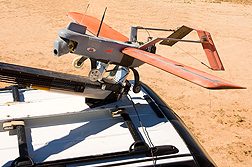This page has been archived and is being provided for reference purposes only. The page is no longer being updated, and therefore, links on the page may be invalid.
| Read the magazine story to find out more. |
|
|
|
|
A Labor Saving Way to Monitor Vast Rangelands
By Dennis O'BrienSeptember 27, 2011
U.S. Department of Agriculture (USDA) scientists have found that unmanned aerial vehicles (UAVs), a tool used by the military, may be suitable for keeping an eye on changing land-use patterns across vast tracts of western rangeland.
Ranchers, government agencies and private land managers often need to survey vast, remote rangelands to see how they are being altered by floods, forest fires or other events. Ground-based surveys can be costly and time-consuming. Satellite imagery is improving, but satellites can't provide the resolution needed by the Bureau of Land Management (BLM) for its assessments of millions of acres of federally owned lands, or by private land owners who want to monitor erosion control, the creep of invasive species, or other land-use changes. UAVs allow operators to survey large areas whenever they want, such as immediately after a major rain storm or forest fire.
At the Agricultural Research Service (ARS) Jornada Experimental Range in Las Cruces, N.M., Al Rango, Jeff Herrick and Craig Winters, along with Andrea Laliberte, a New Mexico State University researcher, are studying the potential effectiveness of a 20-pound UAV with a 6-foot wingspan that cruises 700 feet above the earth, collecting digital images.
ARS is USDA's principal intramural scientific research agency, and this work supports the USDA priority of improving agricultural sustainability.
UAVs are primarily being studied for their potential to collect enough information about landscape patterns to determine which areas merit closer ground level surveys, according to Laliberte.
In a study partially funded by BLM, the researchers took more than 400 aerial images of 700 acres in the Reynolds Creek Experimental Watershed in southwestern Idaho. They assembled the images into mosaics, determined the percentage of vegetation cover using image-processing techniques and compared the data to information collected with conventional ground-based techniques. In a second study, they analyzed the classification accuracy of different types of vegetation, such as mesquite and yucca plants, identified by a computer program designed to analyze mosaics assembled from hundreds of images taken during flights over tracts in Idaho and New Mexico.
Findings from the first study were published in Photogrammetric Engineering and Remote Sensing, and those from the second study were published in Geocarto International. In both studies, the researchers found the aerial data sufficiently accurate to be comparable to information gathered in ground-based surveys for shrubs, grasses and other plants that can be distinguished by their top canopy layer.
Current federal safety requirements and associated costs limit use of UAVs, but the restrictions may change in the future. This research is designed to ensure strengths and weaknesses of the technology are sufficiently understood regardless of the regulations.
Read more about this research in the September 2011 issue of Agricultural Research magazine.

